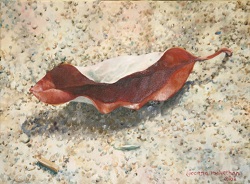Leaf A Float
26 - 12
2012
|
By Joanna A. McKethan How can I cause you to understand what I see in a leaf? I am quite overwhelmed at the very thought of it, and that is why I painted it instead, but I was challenged by someone I respect to take you there with me and show you me in this leaf. It all started on one of my ambling walks a mile up from the Cape Fear River around my property. We have always studied the ground, looking for Civil War relics, special rocks, like arrowheads, and of course, leaves. About ten years ago, when I started painting lush white magnolia blossoms in watercolors, their housing, the magnolia leaves, began fascinating me—the range of their colors back and front, their veins, their backsides…even the texture and material of the leaves. When you feel them, they have a firm, waxy presence, very different from the light, five-fingered sweet gum leaf, for instance. Softer leaves had appealed to me before. Then I found a magnolia leaf on one of my wanderings which looked metallic in its aging process and as I picked it up, I thought, “Someone used this for Christmas decorations and threw it out.” I turned it around and around, studying its different aspects. But no, as it turned out, it had not been gilded by a metallic paint; it was just a deep-yet-bright golden color. I started studying the aging process in leaves and wrote many poems about them “more beautiful in life than death.” And so the one leaf, like the one pictured here, is a portrait of the whole of humanity and the whole of one life in one expression—the form curling in several ways to show the underside which lightened further from salmon colors to lavenders, the veins for all the world like those on an old person’s hands. The coloring aged from a deep green—pretty but rather uninteresting in itself—into the richest burnt sienna’s one could find in her paint pan—radiant, expressive. The form with its curls grew increasingly expressive over time. And so, it was very easy to lavish on this leaf all the love you would give a person, using paint and the skills taught using them studying the in’s and out’s purely for the appreciation of the individuality of the leaf, showing how it responded to light and to shade. Of course all the technical expertise you can learn in a lifetime comes to play in this process, equally inspired by spiritual musings as by richness of sensual pleasure in the rolls of light on form. And its title, “Leaf A-Float” is very symbolic of the leaf having been cut loose from its branch and its tree. We are cynical and say, “yes, so it can die.” But that very looseness, where it is barely attached to the ground except by one point at its stem, is also a picture of resurrection, and a new life—related, but of another substance. And so the leaf stands alone, its body relaying the whole story. |


Leave A Reply
You must be logged in to post a comment.